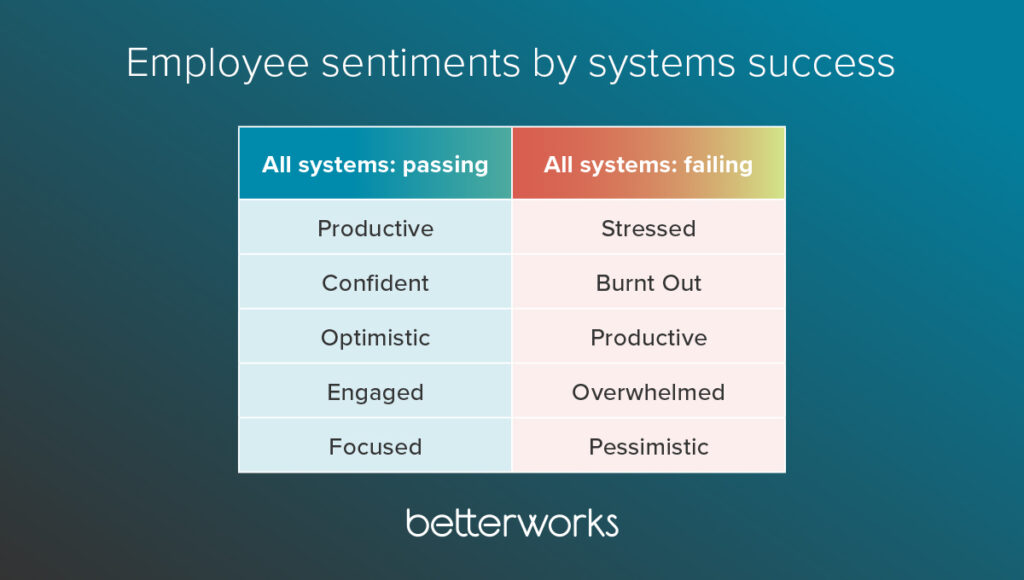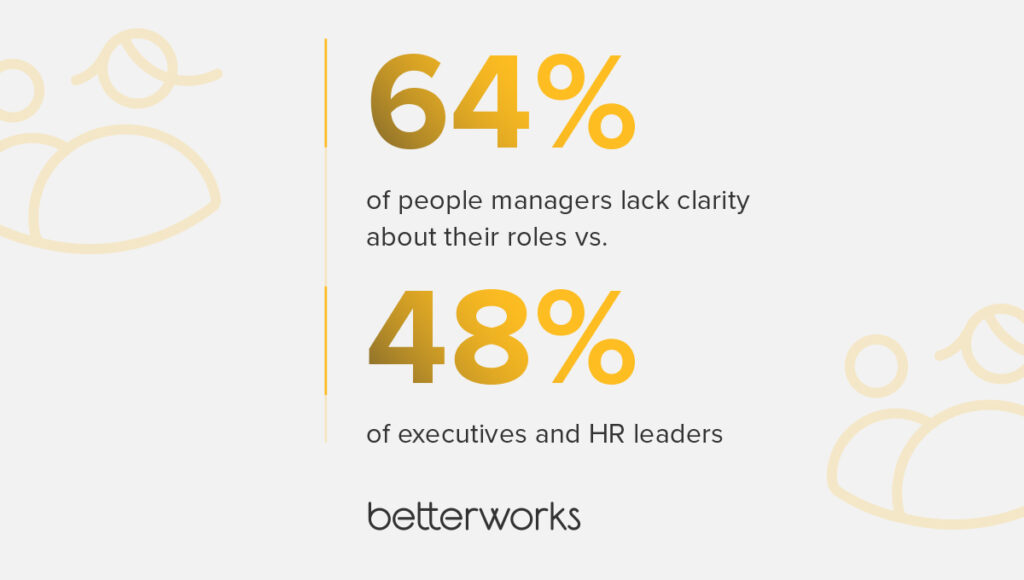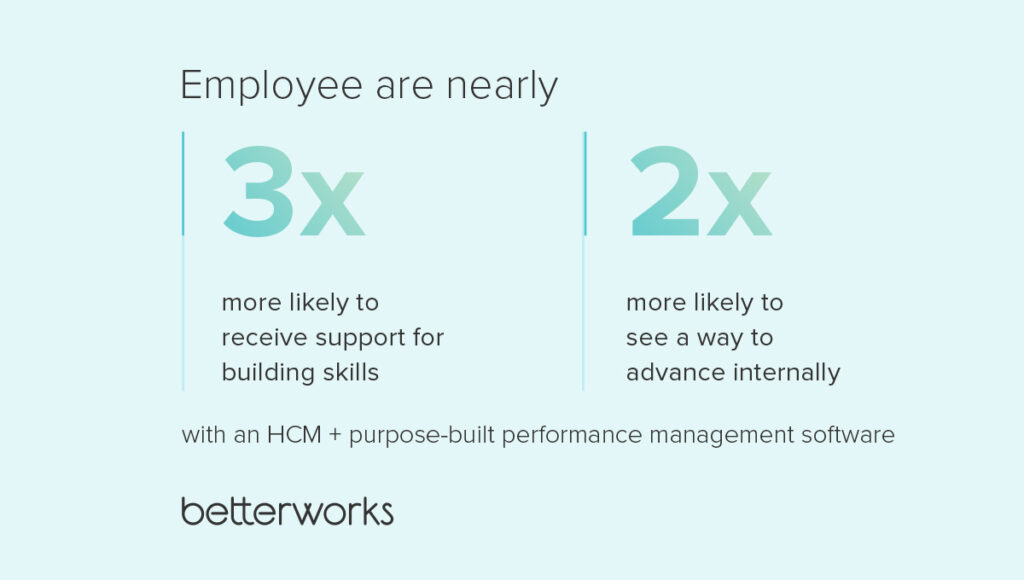- Overcoming the perception gap: Performance management isn’t as good as you think
- Rethinking guidance for employees: Why conversations and feedback are game-changers
- Providing the right guidance for managers in crisis: The squeeze is real
- The technology gap: what’s left on the table with an HCM-only approach
- Address the skills development gap through skills-based performance management
- A multifaceted challenge requires a holistic approach
The latest research from Betterworks’ newly released 2024 State of Performance Enablement report reveals four major disconnects in performance management. These gaps threaten to undermine productivity, retention, employee satisfaction, and the ability of organizations to achieve their strategic goals.
“The link between an empowered, innovative workforce and business sustainability has never been more critical,” said Doug Dennerline, CEO of Betterworks. “However, as business leaders concentrate more on productivity and customer experience in order to navigate the changing business landscape, the shift is producing a gap — a disconnect between leadership’s perception and employees’ reality.”
Titled “The Big Disconnect,” the report represents a clear call for organizations to investigate their performance blindspots and bridge the gaps to ensure that they and their employees can make positive progress in a business environment characterized by the blazingly fast acceleration of change due to automation and AI, uncertainty about the future with AI, the need to upskill, and the changing expectations of the workforce, including younger generations of employees, to name a few.
The disconnects fall into four major categories:
The Perception Gap between leaders and employees who have very different views of the success of performance management.
The Guidance Gap for employees who don’t have regular access to performance-enabling conversations and feedback. There is also a Guidance Gap for middle managers who lack the role clarity and performance support they need to be effective at a time when they are being squeezed by demands from above and below.
The Technology Gap between employees who have access to purpose-built performance management solutions that are integrated with their HCM or ERP versus those who do not — and the impact that has on everything from engagement and productivity to career development and sense of belonging.
The Skills Gap between employees who want skill-building and career development opportunities with adequate coaching and those who actually receive them.
The “Big Disconnect” reveals a challenging landscape for HR professionals and organizations alike, but it can be overcome. The first step is to understand the gaps and their impact.
“The link between an empowered, innovative workforce and business sustainability has never been more critical.”
Doug Dennerline, Ceo, betterworks
Overcoming the perception gap: Performance management isn’t as good as you think
The perception gap in performance management is a critical issue facing organizations. This year’s data reveals that nearly 9 of 10 executives, including HR leaders, rate their own performance management systems as effective. For many employees, it is a far different story, with 44% rating their performance management as a failure. That exceeds last year’s “failure” rating of 37% in the 2023 State of Performance Enablement report. This comes even after the fact that almost half of companies have made changes to their performance management processes, tools, or both, since 2020.
The perception disconnect means leaders may be looking through rose-colored glasses that prevent them from seeing that their workforce actually feels differently: Employees are 17% less productive and three times less likely to feel supported in developing skills than leadership. This year’s survey shows that these problems snowball when employees perceive all aspects of performance management to be failing — manager conversations, peer feedback, ratings and reviews, goals management, and career/skills development — leading to negative employee sentiment.

The first step to overcoming these disparities requires leadership to understand the lived experiences of their employees. Organizations can start by using surveys and focus groups to understand points of friction, be transparent with employees about the findings, and develop plans to address shortcomings, thereby helping bridge the perception gap.
Rethinking guidance for employees: Why conversations and feedback are game-changers
Employees crave meaningful work and clear pathways for growth, yet many find themselves navigating their roles and responsibilities without adequate guidance. In our report, we refer to those without regular 1:1 manager conversations and peer feedback as the “have-nots.” Even among employees with performance management, up to 2 in 5 are not getting the guidance they need to remove roadblocks, problem solve, grow their careers, and gain insights that improve performance and strengthen relationships. This lack of direction can stifle potential and hinder organizational growth.
“By fostering a culture of continuous coaching and feedback, the growth and development of employees can be exponential, which in turn drives superior outcomes.”
caitlin collins, program strategy director, betterworks
For employees who do receive this foundational guidance, their assessment of their ability to perform their work well, grow their skills, and see a path for internal career development grows by multiples according to this year’s data.
“By fostering a culture of continuous coaching and feedback, the growth and development of employees can be exponential, which in turn drives superior outcomes,” says Catilin Collins, Program Strategy Director at Betterworks.
Providing the right guidance for managers in crisis: The squeeze is real
Middle managers play a pivotal role in organizations, acting as the bridge between the strategic objectives of the business and team planning and actions to achieve these goals. They are central to performance management, helping their teams and individual contributors remain on track and engaged, providing guidance, breaking down roadblocks that can hamper effectiveness and productivity, and coaching employees in their growth and development.
Yet, these managers are underinvested in. Studies from RedThread Research and Gartner have borne this out. And more lately, managers have come under attack. Bloomberg recently reported that middle manager job cuts account for more than 30% of white-collar layoffs as companies focus on efficiency. Such cuts are not only short-sighted but dangerous.
Hybrid and remote work has changed the nature of the role, and the expectation of direct reports. Managers retain many of the traditional aspects of their roles with the added responsibility of promoting their team’s well-being and protecting individuals’ sense of belonging and inclusion.
This year’s survey reveals that a majority of managers feel ill-equipped to handle these responsibilities effectively, citing a lack of clear roles, support, and tools as significant barriers. In an effort to deal with the overload, managers have developed several coping mechanisms, some good, like using AI tools to increase efficiency, but others that may be deleterious to their direct reports. These include having more team meetings, fewer 1:1s, and skimping on feedback.

When it comes to managing performance, managers told us they want software that includes regular check-in prompts, recognition-sharing capabilities, platforms for peer-to-peer feedback, and the ability to adjust goals as business priorities change.
The technology gap: what’s left on the table with an HCM-only approach
Two-thirds of companies use an HCM or ERP system for performance-related activities, but this year’s data shows that these systems perform little to no better than manual approaches, like using spreadsheets — and in some cases, HCMs actually underperform manual approaches like using spreadsheets.
These big-ticket items are essential to any enterprise, and often, HCM providers offer secondary performance management modules at no additional cost. Companies are typically hesitant to then invest in best-of-breed, purpose-built performance management software that integrates with HCMs because of the feeling that the performance management modules within these massive systems are “good enough.” It is only after a few years of low adoption, high maintenance, and continued employee complaints that companies begin to realize why HCMs get performance management wrong and consider alternatives.
There is a cost to using a large, compliance-focused, one-size-fits-all HCM or ERP system for performance management that can reveal itself in lower employee productivity and higher costs associated with employee churn, and increased app development costs for necessary customizations. Overall, the data shows that HCMs are 70% more effective with the addition of a purpose-built performance management solution. Yet, less than one-third of companies use such a dedicated performance management platform integrated with their HCM.
For those who do use an HCM + purpose-built performance management software, employees’ view of the success of their performance management is 30-40 percentage points higher across every category of performance: manager conversations, peer feedback, ratings and performance reviews, goals management, and career and skills development. The report shows clear boosts in outcomes, including engagement, belonging, goal alignment, career development, and internal advancement.
Address the skills development gap through skills-based performance management
Skills are the new currency of work. The rapid pace of technological change, particularly with the advent of generative AI, has turned up the pressure on companies. Executives estimate that up to 40% of their workforce may need to reskill as a result of implementing AI or automation over the next three years. The evolving and accelerating demands of the modern workplace highlight a crucial gap in skill development within many organizations.
While 86% of employees express a strong desire for career and skill development and coaching according to Betterworks’ survey, just over half are satisfied with what they receive from their organizations. Bridging this gap requires a concerted effort to integrate skill development into the performance management process. The survey exposed a sizable gap in skill-building success for employees using a purpose-built performance management system integrated with an HCM versus those who only used an HCM.

Traditional performance management must address mastery of skills, not simply evaluation. Modern performance management supports frequent manager-employee conversations about the skills employees need to develop, thus helping to identify skills gaps, and promotes coaching to make sure skill acquisition happens. In this way, organizations can incorporate skill development as part of workforce planning and development.
A multifaceted challenge requires a holistic approach
By reevaluating strategies and investing in the tools and processes that support both managers and employees, organizations can create a more engaged, productive, and resilient workforce. The path toward closing these gaps may feel steep, but with the right mindset and resources, it’s a trail that can be climbed and a summit reached.
In navigating these challenges, Betterworks offers comprehensive solutions that address the core areas of performance management. From facilitating meaningful conversations to empowering managers and prioritizing skill development, Betterworks provides the tools organizations need to foster a more supportive and effective performance culture.
To learn more and get the full details of the research findings, including recommendations and case studies, download your copy of the 2024 State of Performance Enablement.
Bridge the gaps in 2024


